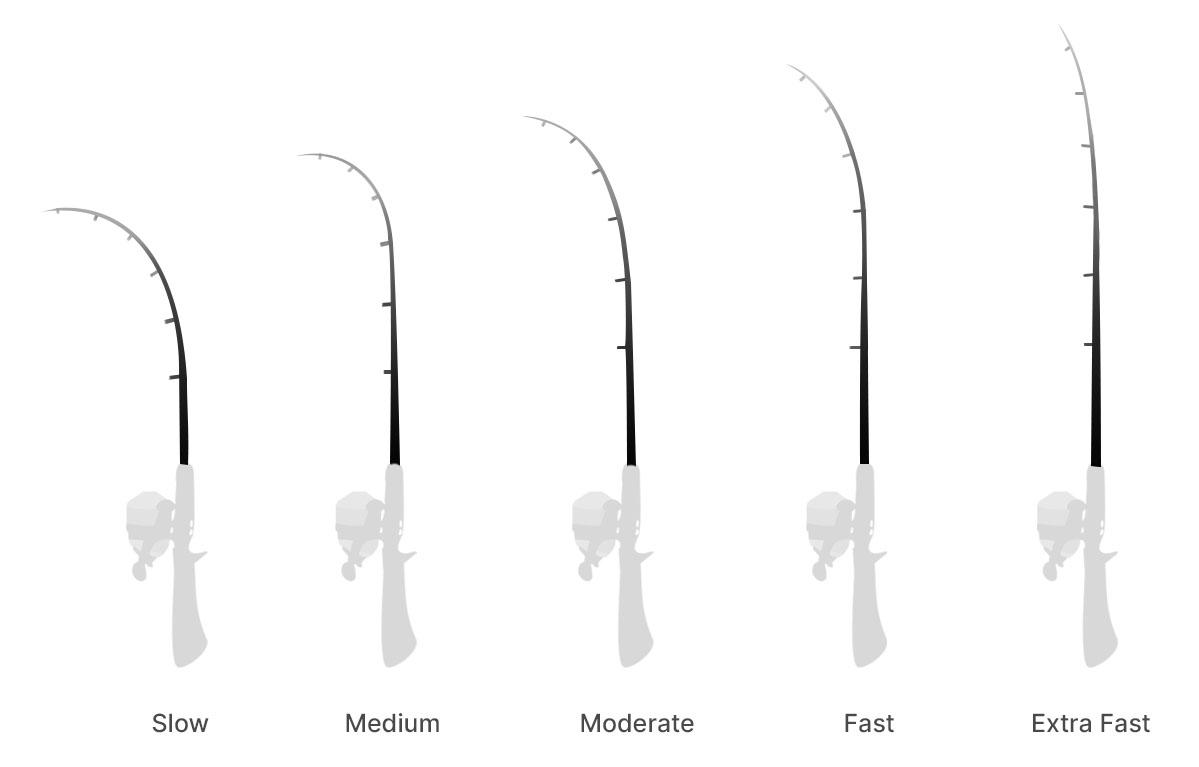Fishing Rod Action & Power Charts
The action and power of a fishing rod quickly describes what it is best used for. Although “power” and “action” are not the most descriptive terms ever, so what they actually mean for the end user can get confusing. In general, rod action refers to where the rod flexes across the length of the rod, and power affects how much the rod flexes.
Another problem with these terms is that there are no industry wide standards for measuring them. Meaning across different brands, two rods of the same action and power may be slightly different. You can also have two rods that are from the same company with the same action but with a different power (or vise versa), and they could each be ideal for two very different types of lures.
Fishing Rod Action
Fishing rod action is a term we use to define where the rod starts to flex when it is under a load. The scale goes from slow to extra fast, with slow bending closer to the reel, and extra fast bending closer to the tip of the rod. The reason we use terms like slow and fast is because action also describes how quickly your rod returns to its normal state after a load is removed, aka how fast it can bend.
Your action is going to affect a few different things, but one of them is your casting. If you really need to fling your bait, you will likely put a large load on your rod in the process, and the less quicker your action, the easier it will be to handle larger lures. As you might imagine, this also affects your max lure weight.

Another significant quality that action impacts is the sensitivity of the rod. The lighter or slower your action, the more you are going to be able to feel. Of course, you don’t always want to feel every little pebble your bait goes over with a bait that's on the bottom, so in that case you would use a faster action rod. Slower action rods are ideal if you are fishing for something small like brim, where a bite isn’t very dramatic.
Fishing Rod Action & Description
| Slow | These are not used often, but could be used on longer cast baits where you want the fish to have plenty of time to bite the bait before you set the hook. |
| Medium | When using treble hooks, spinnerbaits, buzzbaits, or bladed jigs that are worked fast and generate “reaction” strikes. |
| Moderate | When using straight retrieve baits like spinnerbaits, chatterbaits, or crankbaits. Ideal for sweeping hooksets. |
| Fast | Top water baits, or anything that requires quick movements. |
| Extra Fast | When flipping or pitching for bass, or using a bait on the bottom where you need extra sensitivity. |
Fishing Rod Power
If action describes where the rod bends, power describes how much it bends or flexes. You can think of it a lot like stiffness. Its use case is also a lot simpler than action, where you expect to catch larger fish, you need a more powerful rod to handle them. So power can be thought of as strength, or stiffness and you want higher power rods for heavier fish, or if you want to cast heavier lures.
Fishing Rod Power & Target Fish
| Rod Power | Target Fish |
|---|---|
| UL - Ultralight | Panfish, trout, crappie |
| L - Light | Panfish, perch, trout, small bass |
| ML - Medium-light | Panfish, bass, walleye |
| M - Medium | Bass, walleye, pike, lake trout |
| MH - Medium-heavy | Bass, catfish, salmon, pike, catfish (casting) |
| H - Heavy | Bass, catfish, muskie, pike, salmon (trolling) |
| XH - Extra heavy | Catfish, heavy casting for bass with oversized baits or rigs |